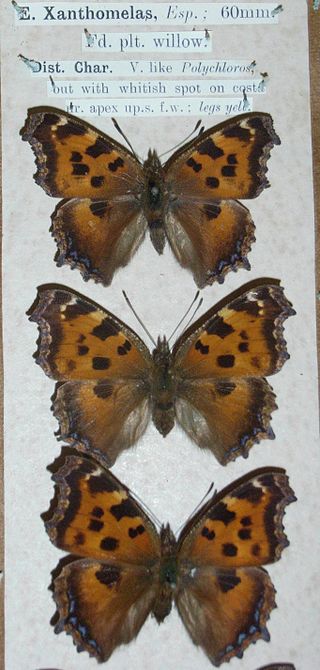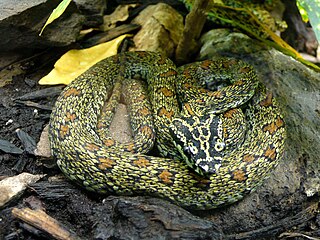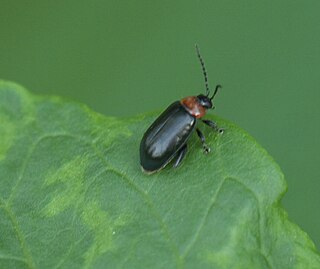
The large tortoiseshell or blackleg tortoiseshell is a butterfly of the family Nymphalidae.

Megalagrion is a genus of damselflies in the family Coenagrionidae. It contains approximately 26 species, all of which are endemic to Hawaiʻi. Megalagrion damselflies are the only native damselflies in Hawaiʻi, and are referred to as "pinapinao" in ʻ ʻŌlelo Hawaiʻi. Other endemic Hawaiian Odonata are the dragonflies Anax strenuus and Nesogonia blackburni, which are referred to as "pinao".

The bumblebee fish is a species of fresh and brackish water goby native to Thailand and Indonesia. This species can reach a length of 3.8 centimetres (1.5 in) SL and is found in lower parts of rivers, coastal areas, mangroves and highly vegetated areas.

Brachygobius is a small genus of gobies. They are popular aquarium fish where a number of species are sold as bumblebee gobies because their colours are similar to those of bumblebees.

Nymphalis xanthomelas, the scarce tortoiseshell, is a species of nymphalid butterfly found in eastern Europe and Asia. This butterfly is also referred as yellow-legged tortoiseshell or large tortoiseshell.

Protobothrops jerdonii xanthomelas is a venomous pit viper subspecies endemic to China.
Kazinag National Park is a national park in Baramulla city of the Baramulla district in the Indian union territory of Jammu and Kashmir notified under Wild Life Protection Act 1972. It is part of a proposal for a trans-Karakoram peace park with Pakistan. The area of Kazinag National Park is 160 square kilometres, and it was commissioned in 1992. The national park is located on the north bank of the Jhelum River.
Brachygobius nunus, the Golden banded goby, is a species of bumblebee goby, a small genus of gobies that takes its common name from their round bodies, big heads, and their overall yellow to golden coloration interrupted by four brown to black vertical stripes reminiscent of the striped pattern of a bumblebee. They have also been figuratively described as "buzzing" from one surface to another inside the aquarium. Like other members of its genus, it is popular as an aquarium fish.

Cipura is a genus of perennial, herbaceous and bulbous plants in the family Iridaceae, related to the genus Cypella. The plants are widely distributed in Mexico, Central, the West Indies, and South America.

The Gobionellinae are a subfamily of fish which was formerly classified in the family Gobiidae, the gobies, but the 5th Edition of Fishes of the World classifies the subfamily as part of the family Oxudercidae. Members of Gobionellinae mostly inhabit estuarine and freshwater habitats; the main exception is the genus Gnatholepis, which live with corals in marine environments. The subfamily is distributed in tropical and temperate regions around the world with the exception of the northeastern Atlantic Ocean, the Mediterranean Sea, and the Ponto-Caspian region. It includes around 370 species and 55 genera: Wikipedia articles about genera list about 389 species.

Brachygobius doriae, the bumblebee goby, is a species of goby native to fresh and brackish waters of Indonesia, Brunei and Singapore, Malaysia, Cambodia, Thailand and Vietnam. This species can reach a length of 4.2 centimetres (1.7 in) TL. It is listed as Least Concern as no threats are known and it is popular in the aquarium trade.
Termessa xanthomelas is a moth in the subfamily Arctiinae. It was described by Oswald Bertram Lower in 1892. It is found in Australia, where it has been recorded from the Australian Capital Territory, New South Wales, Queensland, South Australia and Victoria.
Brachygobius kabiliensis, commonly known as the kabili bumblebee goby, is a species of goby.
Brachygobius mekongensis is a species of goby from the subfamily Gobionellinae which is found in the Mekong basin in southern Vietnam, Thailand, Cambodia and Laos where it lives in slow flowing waters and swamps among tangled roots and vegetation. This species is infrequently recorded in the aquarium trade and is potentially threatened by degradation of its habitat by drainage, water diversion and the building of dams and bridges.
Thermistis xanthomelas is a species of beetle in the family Cerambycidae. It was described by Holzschuh in 2007. It is known from China.

Disonycha xanthomelas is a species in the tribe Alticini, in the subfamily Galerucinae. The species is known generally as the "spinach flea beetle". It is found in North America.
Nygmia xanthomela is a moth of the family Erebidae first described by Francis Walker in 1862. It is found in Sri Lanka, Borneo, Java, Sumatra and Peninsular Malaysia.
Brachygobius sabanus is one of 8 species of goby in the Brachygobius genus, which all share the common name of bumblebee fish or bumblebee goby due to their characteristic black and yellow stripes. Over the past two centuries, efforts to distinguish different species within the Brachygobius genus have occurred within scientific literature; Brachygobius sabanus was described within literature as its own species in 1958, by Robert F. Inger. Other gobies within the genus are B. nunus, B. doriae, B. alcocki, B. sua, B. xanthomelas, B. aggregatus, and B. kabiliensis.











